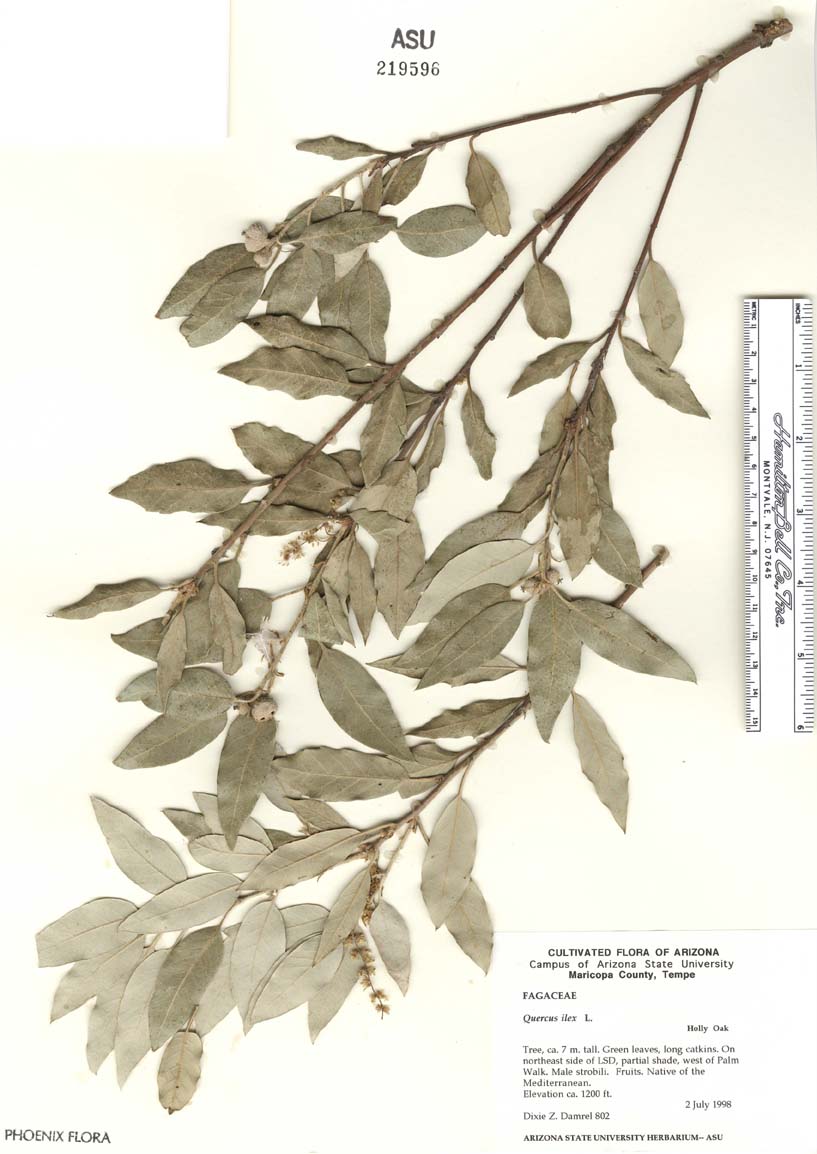- Home
- Search
- Images
- Datasets
- Sample Use
- How to Cite
- Additional Information
- About NEON
- NEON Data Portal
- ASU Biocollections
- About Symbiota
|
Fagaceae |
|
|
Trees or shrubs , evergreen or deciduous, shrubs sometimes rhizomatous. Winter buds sessile, with few to many imbricate scales (2 valvate scales enclosing imbricate scales in Castanea ); terminal bud present or absent. Leaves alternate, spirally arranged, simple; stipules deciduous (usually), distinct, scarious; petiole present. Leaf blade lobed or unlobed, pinnately veined, margins serrate, dentate, or entire; surfaces usually pubescent, at least when young, sometimes with scales. Inflorescences unisexual or androgynous catkins; staminate and androgynous catkins spicate or capitate, rigid, flexible, or lax, consisting of few- to many-flowered clusters, bracts present or absent; pistillate catkins rigid or flexible, with 1-several spicately arranged, rarely solitary, terminal cupules bearing 1-3(-15 or more) pistillate flowers. Staminate flowers bracteate, bracts often caducous; sepals (3-)4-6(-8); stamens (3-)6-12(-18 or more); petals absent; anthers 2-locular, dehiscing by longitudinal slits, pollen sacs contiguous; pistillode often present and indurate, or vestigial as central tuft of trichomes. Pistillate flowers: calyx of 4-6 distinct or connate sepals; petals absent; pistil 1, 3(-6 or more)-carpellate; ovary inferior, locules as many as carpels; placentation axile; ovules pendulous, 2 in each locule, all but 1 in each pistil usually aborting; styles as many as carpels, distinct to base; stigmas dry; staminodes present or absent. Fruits nuts, sometimes winged, 1-seeded, subtended or enclosed individually or in groups of 2-3(-15) by scaly or spiny, multibracteate cupule; seed coat membranous; endosperm none; embryo straight, as long as seed; cotyledons fleshy, starchy or oily. In the Western Hemisphere, Fagaceae are found from southern Canada to Colombia; they are absent or infrequent in most of the northern Great Plains and northern Rocky Mountain region. Fagaceae are one of the most important families of Northern Hemisphere woody plants in terms of total biomass and economic use. They are widely used for lumber, firewood, and horticultural plantings; the nuts are often used for animal fodder and, in some species, for human food (particularly Castanea ). As dominants in forests, woodlands, and chaparral, native stands of fagaceous trees and shrubs provide optimal wildlife habitat, often harboring an exceptionally diverse insect fauna. Most of the diversity of the family in the Western Hemisphere is concentrated in the genus Quercus , with the greatest number of species in Mexico (at least 125 species), and a secondary area of diversity in the southeastern United States. Polyploidy has not been reported in any natural populations of species of Fagaceae. Natural interspecific hybridization is common in the family, particularly in Quercus , and also in Castanea and Lithocarpus . The most important diagnostic feature of Fagaceae is the cupule, which occurs as the cup or cap of the acorn in Quercus and Lithocarpus and the spiny bur that surrounds the fruits of Castanea and Chrysolepis . The cupule is sometimes referred to as an involucre. A true involucre, however, is made up of bracts, while the cupule has been shown to be a complex structure that is interpreted as an indurated, condensed, partial inflorescence formed by fusion of stem axes with several orders of branching, bearing bracts that are modified as scales and/or spines (see B. S. Fey and P. K. Endress 1983).
PLANT: Trees and shrubs; monoecious in ours; hairs unbranched or stellate. LEAVES: usually alternate, simple, deciduous in autumn or persisting nearly 1-3 years, often lobed, pinnately veined; stipules deciduous. FLOWERS: mostly wind-pollinated, unisexual, the perianth much reduced or absent; staminate flowers in heads or aments, the perianth greenish, the stamens 4-9 in ours; pistillate flowers usually tricarpellate, solitary or in clusters of about 3 or more, subtended individually or in groups by an involucre that develops into a woody cupule enclosing or subtending the mature fruit(s). FRUIT: a nut. NOTES: 8 genera, ca. 900 spp., widespread but absent from large portions of tropical S. Amer., tropical and southern Afr., and Australia. REFERENCES: Landrum, Leslie R. Fagaceae. 1994. J. Ariz. - Nev. Acad. Sci. Volume 27, 203-214 |
|

